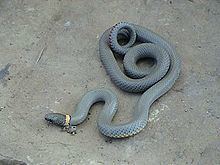Suborder Serpentes Subfamily Dipsadinae Phylum Chordata Rank Subspecies | Subphylum Vertebrata Genus Diadophis Higher classification Ring-necked snake Order Scaled reptiles | |
 | ||
Scientific name Diadophis punctatus regalis Similar Ring‑necked snake, Snake, Reptile, Scaled reptiles, Colubridae | ||
Diadophis punctatus regalis, commonly known as the regal ringneck snake, is a subspecies of ringneck snake endemic to the southwestern United States and northern Mexico.
Contents
Description
The regal ringneck snake is typically gray in color, with a dark-speckled white or cream underside, which becomes bright red or orange near and under the tail. It is distinguished by a yellow to orange ring around its neck which is typically bordered with black. However, the neck ring is frequently absent in this subspecies. The belly color extends onto one or more dorsal scale rows. They are among the larger of the ringneck snake subspecies, growing to a total length (including tail) of 20 to 87 cm (7.9 to 34.3 in). Their dorsal scales are smooth.
Habitat
The regal ringneck snake is found in the mountains, not in the desert as are most snakes.
Diet
The regal ringneck snake, unlike other subspecies, is almost exclusively ophiophagous, having a diet that consists primarily of other snakes, such as the earth snakes (genus Virginia) and the blackhead or flathead snakes (genus Tantilla). They have enlarged rear teeth (opisthoglypha) and a weak venom that serves to immobilize their small prey, but is harmless to humans.
Behavior
Ringneck snakes are nocturnal, secretive snakes which spend most of their time hiding under rocks or other ground debris. If threatened, the ringneck snake typically hides its head and twists its tail in a corkscrew type motion, exposing its brightly colored underside, and expels a foul smelling musk from its cloaca.
Reproduction
Mating occurs throughout the warmer months, with 3 to 10 eggs being laid at a time in a moist, protected area, sometimes in a communal nest with the eggs of several other females. The eggs are on average 19 mm (¾ in.) long by 7 mm (¼ in.) wide.
